The Rides

| THE FLASH | ALADDIN'S CASTLE | CAROUSEL | BLUE STREAK |
| FIREBALL | PAR-O-CHUTES | FLYING TURNS | WATER BUG |
| CUTES | FLYING CARS | FERRIS WHEEL | HOT RODS |
| TUNNEL OF LOVE | BUMPER CARS | TRAINS | WILD MOUSE |
| CATERPILLER | STRAT-O-STAT | THE COMET | THE ROTOR |
| JETSTREAM | STILL MORE |
Rides, Rides, and Even
More Rides
When George Schmidt opened the park in 1904, everyone thought it was the last word in thrills and excitement. Goat cart rides were considered great entertainment at the time; and the White Flyer, or Figure Eight Roller Coaster plus The Mill on the Floss ride defied the laws of gravity. In 1908, The Shoot-the-Chutes and The Velvet Coaster added up to a thrill a minute; but, as they say, "That was only the beginning."
THE FLASH HAD ITS BEGINNINGS when presented as the Pippin Roller Coaster in 1921. It was renovated and re-introduced as the Silver Streak in 1938, the Silver Flash sometime later, and just plain The Flash from 1961 through 1967. Built of wood, the coaster had unique stainless steel covered cars, though they were not covered when it was the Pippin. The coaster was demolished shortly after the park closed in 1967.
 |
|
| Pippin Coaster, 1921 Sharpshooters Productions, Inc. |
|
|
|
|
|
The Silver Flash Boarding Station
Photo by Fred R. Krauss |
The Silver Flash in Action, 1940
Photo by Fred R. Krauss |
|
Silver Flash Entrance |
|
.jpg) |
ABOVE: The Entrance to the Flash Roller Coaster,
|
| Return To Index |
ALADDIN'S CASTLE, everyone's favorite Fun House, opened in 1932 and was a necessary stop for each trip to Riverview. Visitors would follow a long walkway that wound through the castle on different levels and into many curious rooms. Each room boasted disorienting features to keep guests pleasantly confused.
.jpg)
Aladdin's Castle: The Ultimate Funhouse of Its Time
Photo by Chuck Wlodarczyk/Pinball News site
|
|
|
|
The Mouth of Aladdin
Tribune Archive Photo |
|
|
|
|
|
Fun House Trick Mirror
Sun-Times File |
|
The first obstacle was an entry maze with dozens of identical screen doors, only a few of which could be swung open. A room full of mirrors which distorted your size and shape into gross caricatures was next and led to rooms with slanted floors that made walking very difficult. The next section of hallway -- dark of course -- had discs on the floor which rotated when stepped upon; and finally, visitors met a huge rolling barrel that they needed to walk or, more likely, crawl through.
But unless guests were familiar with all of the tricks, the worst was yet to come. There was an outside stairway, and many females proved victims to Aladdin's devious nature. The path brought you out right in front of the castle on the second level, visible to everyone waiting in line or passing by. One of the operators sat secretly in this passageway. As an unsuspecting girl walked over a grid, an operator released a jet stream of air sending her dress or skirt up over waist -- an embarrassment to her but entertainment to the audience of onlookers standing along the fence. After that, came more dark passages, a bumpy ride down a series of padded rollers, and finally a metal seat which collapsed when you sat on it.
Visitors finally were sent cascading down the Magic Carpet -- an undulating cloth passing over more rollers that resembled a large slide and led out to the exit. Even after you knew all of Aladdin's secrets, negotiating his magical castle still provided thrills and lots of fun.
Note: The distortion mirrors from Aladdin's Castle fun house are reportedly at a dance club in Palatine, Illinois.
| Return To Index |
A CAROUSEL WAS COMMISSIONED IN 1906 and installed in 1908 after bored wives complained of nothing to do at the park while husbands were busy with target practice. Called the E. Joy-Morris Carousel, it was one of the the third largest ever built and had five rows of 70 large hand-carved and painted horses by Swiss and Italian woodcarvers from the Philadelphia Toboggan Coaster Company. The carousel was located just inside the main gate, cost $18,000, and was kept in pristine condition throughout its life at the Riverview.
|
|
|||
| Carousel or Merry-Go-Round, 1908 Souvenir Postcard |
|||
 |
 |
 |
 |
|
Some of the Magnificent "Rides"
|
|||
|
|
LEFT: This wooden carousel horse was hand-carved and painted by Leo Zoller. The horse has glass eyes and is black and white with a sculpted gray mane and tail. Sculpted feathers with red and blue tips are around his neck. A sculpted golden-yellow lion pelt with a head, legs and tail makes the saddle. Brown leather strap/reins attached at the mouth with metal hardware. The horse is in galloping pose with legs bent up towards the body. Dimensions: Height: 51 in; Width: 17.5 in; Depth: 70 in |
||
 |
|||
| The building housing the lovely carousel was equally beautiful. Souvenir Postcard |
|||
In 1967 when the park was closed, Mayor Robert Buehler of Galena, Illinois, purchased the carousel, but the town could not afford to rebuild the ride. The carousel sat in pieces in local basements until 1971, when Buehler sold it to Six Flags over Georgia. Buehler had kept one horse for himself but donated it to the Chicago History Museum in 2003.
In Georgia, the carousel was restored to its original luster and is now in use just outside of Atlanta at Six Flags Over Georgia. A wedding cake-shaped shelter — identical to the one that protected it at Belmont and Western — was constructed to protect the storied ride from the elements. It is still called the Riverview Carousel, and it is the only ride from Riverview Park that is in operation anywhere. Due to its historic significance, the carousel was placed on the National Register of Historic Places in 1995.
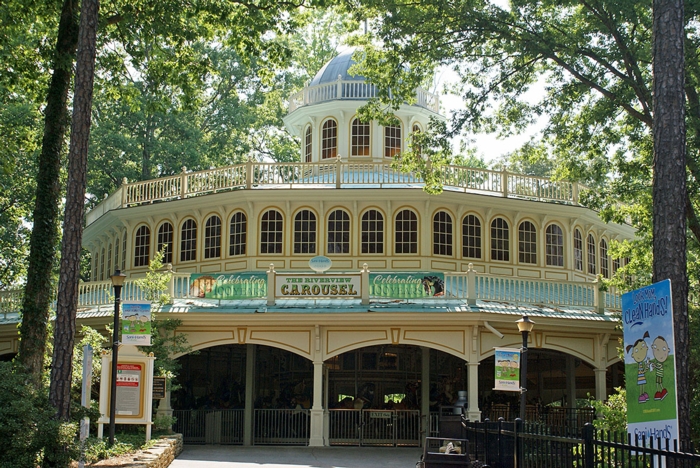 |
 |
| Carousel House and Plaque Photo Credit Six Flags Over Georgia |
|
| Return To Index |
THE BLUE STREAK ROLLER COASTER began as the Skyrocket in 1923, was operated as the Blue Streak from 1936 to 1958, and then introduced as The Fire Ball.
 |
|
| The Skyrocket Coaster, 1923 Sharpshooters Productions, Inc. |
|
 |
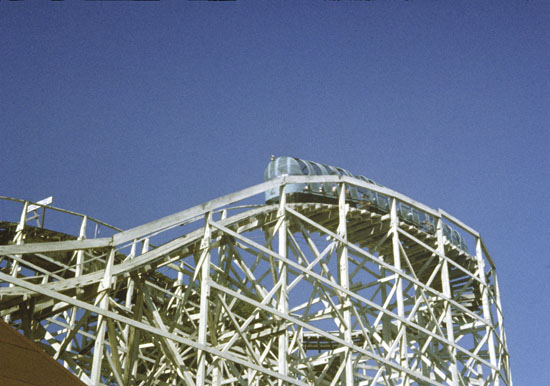 |
| Blue Streak's Route Snarpsnooters Productions, Inc. |
The Blue Streak, 1st Turn Photo by Fred R. Krauss |
 |
|
| Entrance to Blue Streak Roller Coaster Souvenir Post Card |
|
THE FIREBALL ran from 1959 through 1967 and was hyped as the fastest roller coaster ever built. The first year it operated, it was advertised to travel at 100 mph. The following year the claim became 90 mph; and when the ride was shut down, the speed had deflated to a mere 70 mph.
.

The Fireball Roller Coaster
http://www.flickr.com/photos/zeusofhollywood/3374336763/
The plan for the Fireball called for a drop of 95 feet, but a Chicago ordinance prevented a hill that tall from being built. To conform to the ordinance but still build the coaster as they wanted, park engineers dug 10 feet into the earth to achieve the desired drop.

Chicago American's newspaper carrier boys ride the Fireball, 1962.
Tribune Archive Photo
| Return To Index |
IN 1910 THE EYEFULL TOWER, more than 200-feet high, was built and included an elevator to carry visitors to the top and view the city's panorama. Then, in 1936, when paratroops were unimagined and parachute jumping was reserved in the popular mind for daredevils and desperate aviators, George Schmidt used that tower for controlled parachute drops -- The Pair-O-Cutes. It was a thrill-seekers ride, and people even became stuck at the top and dangled there for hours.
The tower itself could be seen for miles, but you always thought upon sighting it that the park and the fun it promised were only a few blocks away.

The Pair-O-Chutes Tower at Riverview Park
Photo by Chuck Wlodarczyk, Tribune Archive
|
PHOTOS: Fred R. Krauss |
ABOVE: |
A Close Up of a Ride Down
Kids couldn't wait to be old enough to ride the Par-O-Chute and would try to predict when the collapsed pyramidal chute on its slow upward ride would trip the release and begin its 200-foot free-fall. Then they would hold their breaths until the chute billowed with air and slowly began its descent. The ride offered a more exciting way to get a bird's eye view of the park — if you remembered to look around.

Pair-O-Chutes
Souvenir Post Card
. . . and now for a real taste of a ride on the Par-O-Chutes!

Yep, they even found a minister to marry them!
Am wondering if a bridal party followed them down. (1939 or 1940)
Chuckman Photo on WordPress
| Return to Index |
THE FLYING TURNS was purchased by Riverview after the closing of the 1933-1934 Chicago World's Fair where it had been one of the Midway's main attractions. It's said this thrilling, wooden bobsled-type roller coaster gave riders a feeling of being in flight. Cars ran in a wooden trough -- resembling a half barrel -- instead of riding on top of tracks like other coasters. The train of cars followed a tunnel without a roof and was switched back and forth on the sides of the half-walls as it flew around the turns.
Riverview had wanted to purchase a Flying Turns ride new from the manufacturer, but it was unable to come up with the funds to buy one so they were forced to purchase one used at the Fair.

Arial View of the Flying Turns, 1935-1967
Sharpshooters Production, Inc. site
This popular ride remained at the park until its close at the end of the 1967 season. A new Flying Turns based on the Riverview blueprints is being constructed at Knoebel's Grove Amusement Park in Elysburg, Pennsylvania.
 |
|
| Long lines formed at the Flying Turns entrance as soon as it opened in 1934. Chuckman's Photos on WordPress |
|
 |
 |
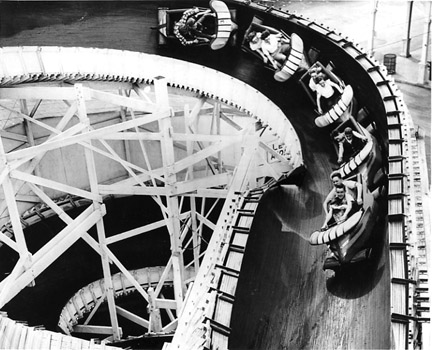 |
|
|
Fun-seekers at Riverview Park ride the Flying Turns, 1962. |
|
 |
RIGHT: George Yautz and Helen Olson sample the breath-taking thrill of a ride on Riveriew Park's steeply banked Flying Turns in anticipation of opening day at the amusement park in May 1951. Tribune Archive Photo |
| Return To Index |
THE SEAT OF THE WATERBUG was in the middle of a large motorized tube with a steering wheel. The object was to drive around the pool and "meet" as many other tubes as possible. Bumping was encouraged, of course, and water flew everywhere. The ride was originally built and operated at the 1939 New York's World Fair; but because of the shortage of rubber, it was placed in storage when WWII broke out. Riverview claimed the ride and presented it to the public in 1946.
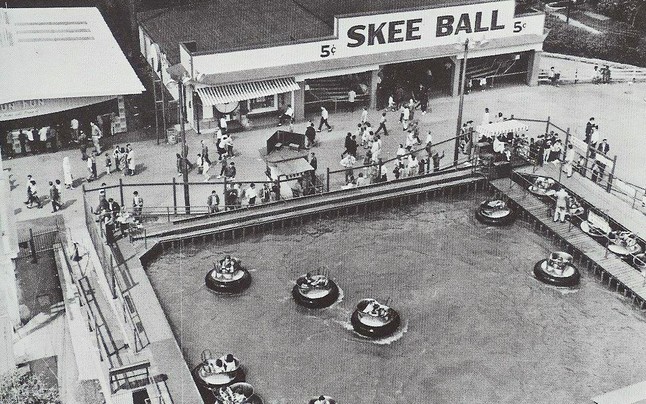 |
 |
|
The Water Bug
|
Couples laugh as they ride the Water Bug |
 |
|
| The Water Bug Souvenir Postcard |
|
| Return To Index |
THE EVER-POPULAR SHOOT-THE-CHUTES, known as The Chutes for short, began with a ride in long, flat boats through a dark tunnel to an elevator which then raised each boat to the top of the chute. Once there, the boat paused, giving riders spectacular views of the entire park; and then the boat tilted forward and plunged downward on a film of water into a large lagoon at the bottom.

Shoot-the-Chutes combined a "cooling ride down a ramp with a nautical thrill
of splashing into the lagoon," the Tribune reported.
Tribune Archive Photo
The Chutes, constructed in 1907 and rehabbed in the 1920s, was one of the oldest rides in the park. Riverview management purposely kept the Chute's landing pool a murky brown color so people wouldn't realize the bottom was merely five feet down at its deepest.
|
|
|
|
From beginning . . . . . . . . . . . . . . . . to end! |
|
There was no Disneyland underwater track guiding the boat in the lagoon. Each boat was free-floating and splashed violently into the lagoon -- unbeknownst to the riders, the operator aided the "violence" by rocking the boat. Then, the operator had to quickly and efficiently use the rudder to pull the boat into a 180 degree turn to reach the unloading pier. Another worker waited with a ten foot pole and hook, snagged the boat, and brought it to berth.
Take a seat and let's watch . . .
 |
| Tribune Archive Photo |
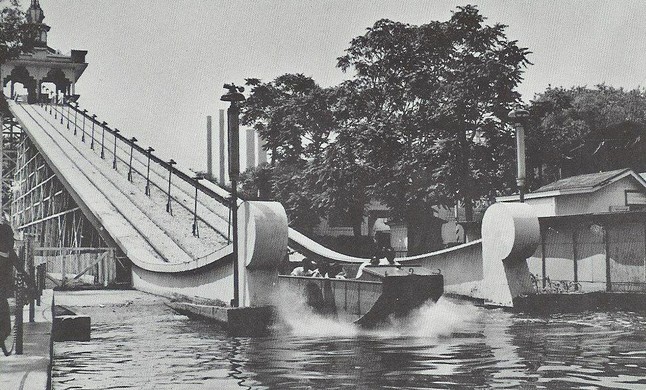 |
| Souvenir Postcard |
 |
| Sun-Times file |
 |
| Souvenir Postcard |

Watching the Fun
Chuckman Photos on WordPress
| Return To Index |
NOT ONLY DID THE CARS OF THE FLYING CAR RIDE roll around inside a looping track, the entire drum rotated in a circle! This sent riders on a 30 mph spin.
 |
 |
| ABOVE: Their faces sum up the thrilling experience perfectly: joyous abandon and sheer terror. There was plenty of both to go around on the looping Flying Cars ride at Riverview Park. Chicago Tribune Historical Photos |
And now, take another ride on the Flying Cars
| Return To Index |
THE FERRIS WHEEL offered panoramic views of Riverview Park's Midway and its surrounding neighborhood on its leisure trip through space.
 |
 |
| TOP: Mike Nelson and Sondra Brewer wave from atop the giant Ferris wheel in 1964. Tribune Archive Photo |
| Return To Index |
THE NEW HOT RODS RIDE was one of the most popular attractions of Riverview's 52nd season.
 |
 |
|
Couples enjoy "rodding" around!
|
|
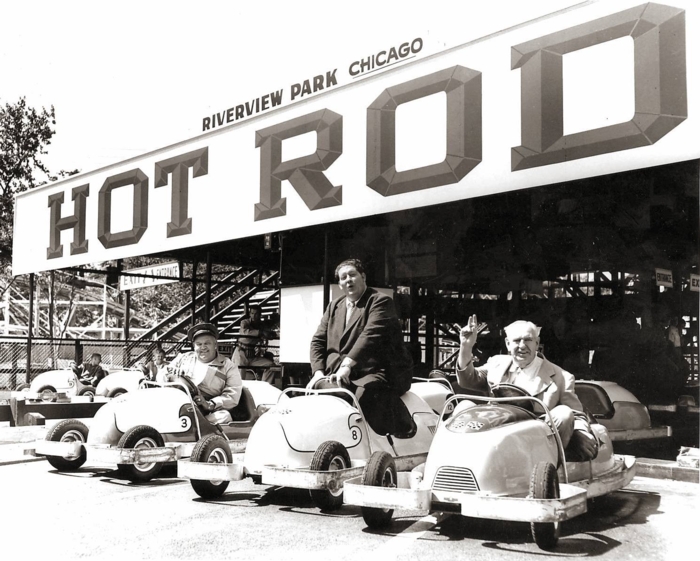 |
|
 |
ABOVE: This 1954 photo features Riverview spokesman Dick "Two Ton" Baker, Bobs' manager Carl Jeske to the left of Baker, and park manager George Schmidt on his right. Baker's television and print commercials usually had him saying, "Laugh your troubles away at Riverview!" These commercials lasted until the Park closed.
LEFT: The thrill of racing at close quarters comes to Mickey Blair and Bob Beckman -- left -- and Charlene Beck and Bob Darnay on this new Hot Rods ride in 1955. |
| Return To Index |
THE TUNNEL OF LOVE, also called Mill on the Floss and the Thousand Island over the years, was a boat ride traveling through lovely landscaped canals and long, dark tunnels. In its final years, the boat traveled under The Whip, a long rectangular shaped tilt-a-whirl, which sounded like loud thunder to those riding below in the Tunnel of Love.
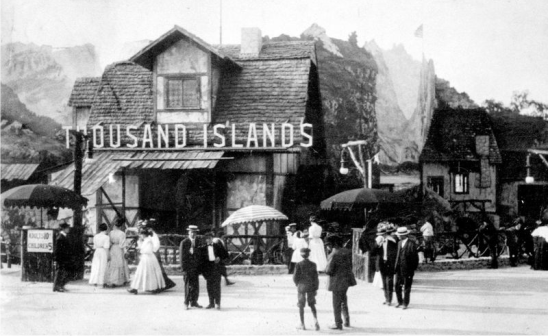 |
 |
| From Thousand Island . . . . . . . . . . . . . . Souvenir Postcard |
. . . . . . . . to Mill on the Floss Souvenir Postcard |
AND TO
 |
Water Wheel at the Tunnel
|
| John Curran and Ann Marie Wenthe sail into the Tunnel of Love in July 1962. Tribune Archive Photo |
|
 |
|
| These sailor boys didn't know it, but the infrared camera sees all -- even in the dark. The scene is the Mill on the Floss/Tunnel of Love ride in August 1943. Chicago Herald American |
|
| Return To Index |
. . . and a whole lot more!
WHILE BUMPER CARS HAVE ALWAYS BEEN A POPULAR ATTRACTION at amusement parks around the United States, bumping was not always the point – hence the name Dodg 'em. Originally, the purpose was to give kids a chance to drive and avoid hitting the other cars, though inevitably, bumping became part of the action. Years later, crashing became the point, not dodging.
|
LEFT: Original Dodgem Ride, Chuckman's Photos on WordPress RIGHT: Bump-em Cars, which was more appropriate their original name, Dodgem Cars. Tribune Archive Photo |
|
| Return To Index |
THE NEW DIESEL-POWERED RIVERVIEW CHIEF, pictured making its way around the lovely grounds of the Showboat Lagoon, proved to be a favorite of the younger set. The Scout was the second diesel locomotive in operation. The train engines had been steam locomotives until 1948.

Riverview Chief
Souvenir Postcard
|
RIGHT: Children from St. Hedwig Orphanage look over a miniature train at Riverview Park on July 30, 1946. Sister Mary Oswalda, right, was in charge of the group of boys.
BELOW: Young and old always enjoyed a trip aboard the miniature trains around Riverview's grounds. |
|
|
|
|
| Return To Index |
THE WILD MOUSE WAS a metal-framed coaster, which resulted in fast, bumpy, sudden turns and jarring rides. Large signs warned riders to remove their eyeglasses; some did and some were sorry.
 |
.jpg) |
|
ABOVE: Wild Mouse Chicago American's news carrier boys enjoy a ride on the Wild Mouse on July 17, 1962. LEFT: The Wild Mouse Entrance |
|
|
|
|
| A couple enjoys the Wild Mouse. Tribune Archive Photo |
|
| ReturnToIndex |
THE CATERPILLAR WAS A CIRCULAR RIDE with a continuous string of cars following a track. The track, of course, had humps in it; and the ride was generally operated quite fast. When the ride was up to speed, a canopy would rotate over the cars to enclose them.
 |
| Caterpiller Ride loaded and ready to ride -- canopy is open. Ridezone.com |
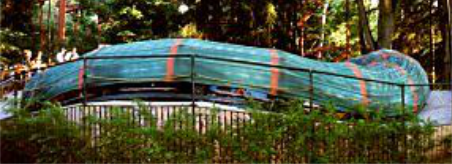 |
| Caterpiller Ride with closed canopy -- quite popular with young couples. Ridezone.com |
While covered, there was usually a fan that blew air up into the cars at one point on each rotation. The Caterpillar was once a very popular ride found at many amusement parks. Today, there are only a few left operating with reports of a few being in storage.
 |
The photos above show the Caterpiller ride at Idlewild Park in Ligonier, PA, which was similar to the ride at Riverview. To the left is a photo of the porcelain signs that adorned each car of the Caterpiller at Riverview. |
| Architectural Artifacts |
| Return To Index |
THE AERO-STAT / THE STRAT-O-STAT was one of Riverview's longest lasting attractions. Originally installed near the front gate, it was moved to the rear of the park around 1908. The original cars were changed in the mid-teens to ones that looked like biplanes; but in the 1930's, the park installed cars that looked like rocket ships and renamed the ride The Strat-O-Stat.
 |
.jpg) |
|
Strat-O-Stat (Aero-Stat)
|
|
|
The Strat-O-Stat ride at Riverview Park |
| Return To Index |
BUILT IN 1920, THE BIG DIPPER thrilled patrons for 16 years before it was overhauled and re-introduced as The Zepher. In 1940 another remodeling job turned it into The Comet, which we well remember.
.jpeg) |
 |
| The Big Dipper Coaster Ride Sharpshooters Productions, Inc. |
|
 The Comet Roller Coaster Photo by Bob Smitka/Pinball News |
|
| Return To Index |
THE ROTOR IS A LARGE, UPRIGHT BARREL, rotated at 33 revolutions per minute. The rotation of the barrel creates an inward acting centripetal force supplied by the wall's support's force, equivalent to almost 3g. Once the barrel attains full speed, the floor drops, leaving the riders stuck to the wall of the drum. At the end of the ride cycle, the drum slows down and gravity takes over. The riders slide down the wall slowly. Most Rotors were constructed with an observation deck. (Some compare the Rotor to an unsafe human blender.)
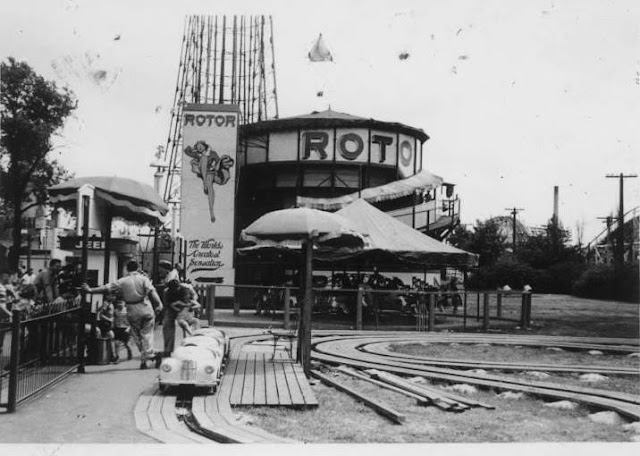 |
|
| The Popular Roto Ride at Riverview Digital Research Library of Illinois History Journal |
|
 |
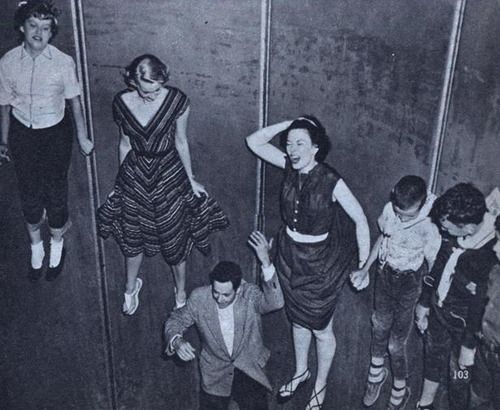 |
| Riverview's Rotor had an observation deck similar to the one pictured above. History Daily |
Roto Riders feel the full effects of centrifugal force. |
| Return to Index |
THE GREYHOUND ROLLER COASTER was one of Riverview's oldest, longest, and mildest roller coasters. It began service as the Gee Wiz in 1912 and became the Greyhound a year later. In 1965 the ride was rebuilt and renamed The Jetstream. The new coaster was shorter than its predecessor and not as profitable as its wilder cousins like The Bobs and The Comet.
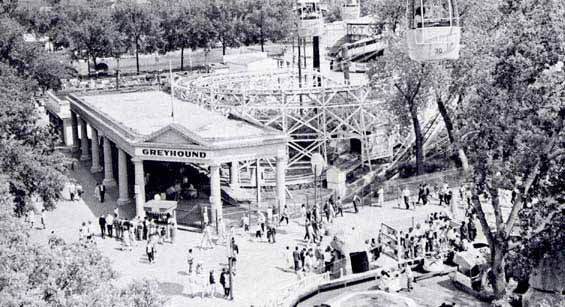 |
|
| The Greyhound, 1913-1965 http://www.bowen57.net/RiverviewMemories.html |
|
 |
|
| The Jetstream Roller Coaster, 1965-1967 Sharpshooters Productions, Inc. |
| Return To Index |
|
|
|
| Riverview Park's Flying Scooter, seen here in May 1950, provides breathtaking thrills as it soars at treetop height. Tribune Archive Photo |
A group of boys from Maryville Academy, guests on opening day, ride on the Calypso at Riverview Park on May 12, 1961. Harold Norman, Chicago Tribune |
|
|
|
|
Miniature version of "The Whip" |
Kiddie Cars
Sun-Times file |
|
|
|
|
Up and down, around and around -- that's the pattern of the Bubble Bounce ride,
one of the most popular rides at Riverview Park, 1955. Tribune Archive Photo |
|
|
|
|
|
Marilyn Hallett -- on the left -- and Ken Holman and Margaret Allen find the Boomerang a thrilling ride as it whips swiftly around sharp turns in 1951.
Pinterest
|
Three young classmates find the new Paratrooper ride a thrilling aerial adventure in 1960. The ride is one of the four major new attractions at the Park.
Tribune Archive Phot |
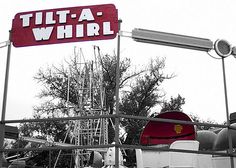 |
 |
|
The Tilt-A-Whirl consists of freely-spinning cars attached at fixed points to a rotating platform, which is raised and lowered. |
In the Crazy Dazy ride of Riverview, several teacups spin around on their own platform and can also move to the platforms of other tea cups as well. This methodical chaos provides dizzying fun for its riders. |
 |
|
The riders of the Ghost Train -- sometimes called Spook Town -- climbed aboard small cars that took them through swinging doors and into darkness. Monster figures would leap out; eerie noises fill the air;
and creepy things touch you. (In reality they were just ropes; but in the darkness, you couldn't tell.)
Vanished Chicagoland
 |
|
 |
|
|
Hades Walk-Through Fun House Entrances through the Years |
|
|
|
|
|
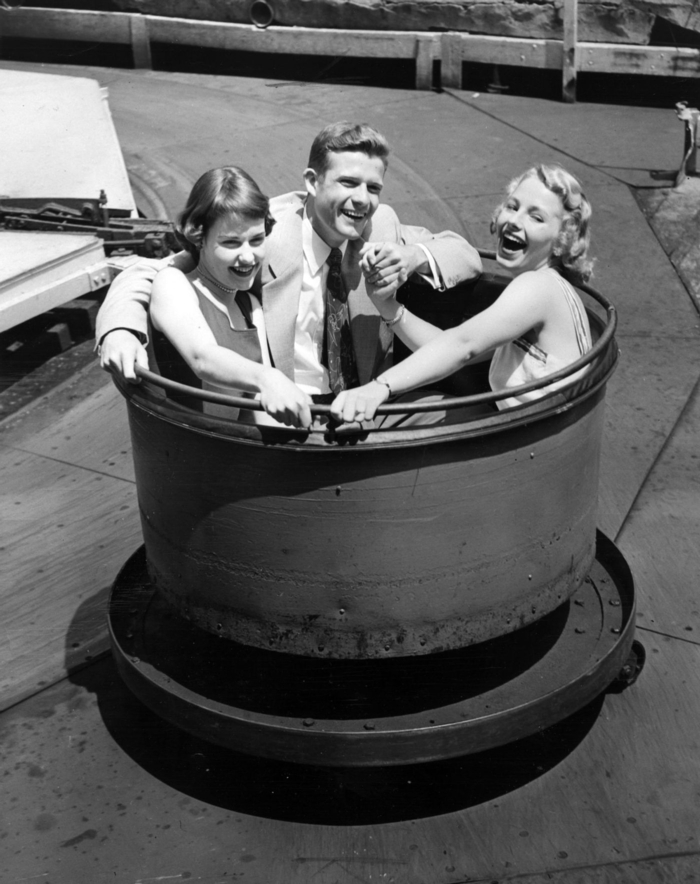 |
|
High in the sky and having fun is a group
of passengers on the $300,000 Space Ride at Riverview Park in 1963. It carries its riders over the park on an elevated cable. Tribune Archive Photo
|
Marilyn Hallett -- on the left -- and Ken Holman and Margaret Allen find Riverview Park's popular Boomerang a thrilling ride as it whips swiftly around sharp turns in 1951.
Tribune Archive Photo |
|
|
|
|
The Whip was a long rectangular shaped Tilt-A-Whirl which
dramatically whipped each car around its two ends. Wikimedia Commons |
|






.jpg)




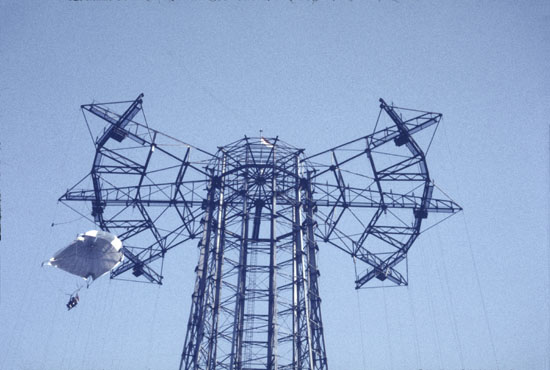






















.jpg)